Basic Tips for FOIL DINNER Success (No Matter Where They're Cooked)
When you hear "foil dinner" don't you instantly think of a campout? But what was once a staple for Boy Scouts or a family camping trip is now becoming a staple for cooks-on-the-go.

No matter how you cook it-in your oven, on a grill, over hot coals, or buried in the ashes of a campfire-a foil dinner delivers. Besides being a quick and efficient way to get a meal on, this meal is packed with deliciousness. What a clever way to make your favorite recipes!
And that's the other thing: This cooking approach lends itself to almost everything but soup. It's quick, efficient, delicious, and versatile. With a few tricks, just about any recipe can be cooked in foil.
If you're new to foil packet cooking, here are some basic tips for foil dinner success (found on a trusted site, www.beprepared.com):
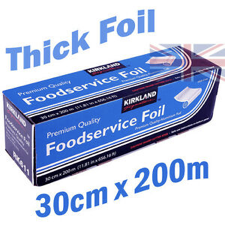
Use heavy duty foil to prevent rips and leaks. It also protects your meals from getting ashes in them. If you only have regular foil, double or triple wrap your meal.
Seal foil packets with foil folds. Our first inclination is to close the packet by crunching the sides of the packet, but doing this creates opportunities for juices to escape. Folding excess foil ensures everything stays put.
In fact, a good foil pack is essential to foil dinner success. Depending on what you're cooking there are two folds to consider. A very cool site, The Art of Manliness, teaches these folds:
THE FLAT PACK. It's best for meat, where you're looking for more browning than steaming.
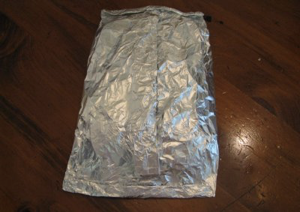
1. Place the food in the middle of the foil sheet. If needing to mix ingredients, do so in a separate bowl, then transfer it to the foil.
2. Use a sheet of heavy-duty foil that is about twice as long as the food you'll be wrapping. Most individual dinners need a piece of heavy-duty foil about 12 x 18 inches.
3. Bring the long sides together in the center and crease them together, making tight folds until the foil is flat next to the food.
4. Tightly roll up the shorter sides until they meet the food.
THE TENT PACK. This provides a pocket of air that allows for greater steaming. Thus, it's best for foods you want steamed (fruits, vegetables, and meat/vegetable combos).
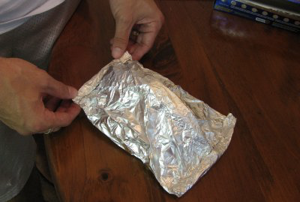
1. Use a sheet of heavy-duty foil that is about twice as long as the food you'll be wrapping (just as you would for the flat pack).
2. Place the food in the middle of the foil.
3. Bring the long sides together in the center and tightly fold them together towards the food. This time, stop folding a few inches before you get to the food, leaving a pocket of space and creating a "tent."
4. Tightly roll up the shorter sides, again leaving an inch or so of space between the end of the fold and the food.
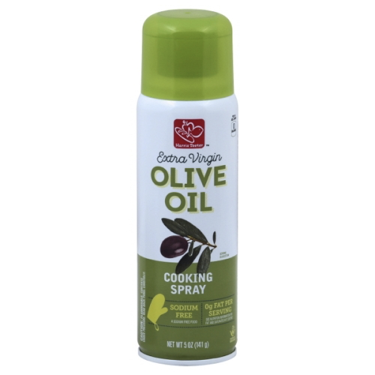
Always spray the foil with cooking spray to prevent sticking.
Put meat on the bottom of the packet. Meats take the longest to cook. If you're using pre-cooked meat, like many freeze-dried meats, then it doesn't need to be at the bottom of the packet.
Use thin meat. Pound or slice meats to make them thinner for thorough cooking. Bite-sized pieces work best because they're easier to eat straight out of the packet (no knife required!).
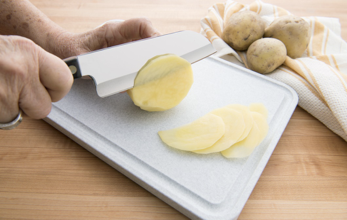
Cut hard vegetables into thin slices (i.e. potatoes and carrots) as they'll take as long as the meat to cook. Other vegetables can be cut into chunks. The exception to this is freeze-dried or dehydrated potato or carrot dices-they're already small and will cook quickly.
Be careful with seasonings. Some people recommend using more seasoning than usual in a foil dinner, especially if cooking on a campfire. But remember, freeze-dried meats can have high sodium content. Keep this in mind as you add seasonings.
Cook on the fire's coals (a two-inch-thick bed), not on the fire itself.
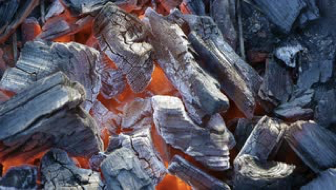
Always cook on "mature" coals (the white coals rather than red ones). You can also bury your dinner in the hot ashes at the edge of the fire, or cover the packet with coals if it has a lot of food in it.
Start with your packet meat-side down. Using tongs, turn it at least twice during the cooking process. Test the meat and potatoes. Re-wrap and cook longer, if needed. If using freeze-dried meat (remember it's already cooked), you only need to "cook" it long enough to heat it up and blend the flavors.
Use pre-cooked rice and pastas before adding them to your foil dinner mix (except for instant rice, sauce, or gravy).
Always add moisture to the packet (a couple tablespoons of sauce-Worcestershire, Soy, barbecue, salsa, etc.-melted butter, milk, salad dressing, water, or ice cubes). If cooking meat, always include high-moisture veggies (tomatoes or onions) to prevent the meal drying out.
Sprinkle in oil when cooking potatoes, so they don't stick. Season well.
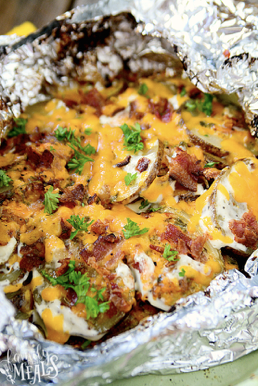
Add cheese after cooking, upon opening the package. If you add it during cooking, it will stick to the foil and burn.
Add Cabbage to prevent burning. If you're worried about your food burning, encase your meal in cabbage leaves before wrapping in foil. If your dinner gets over cooked, the cabbage will burn, but your meal won't.
Open your packet carefully. When you finish cooking or if you're adding cheese, open your packet slowly and carefully to avoid steam burns.
- www.chelseasmessyapron.com
- www.ebay.co.uk
- www.theartofmanliness.com
- www.grocery.harristeeter.com
- www.cutco.com
- www.videoblocks.com
- www.familyfreshmeals.com
 Alice Osborne
Alice Osborne
Weekly Newsletter Contributor since 2006
Email the author! alice@dvo.com
